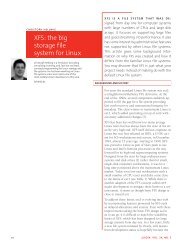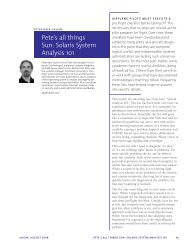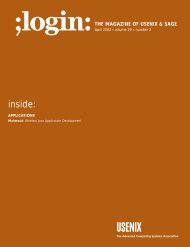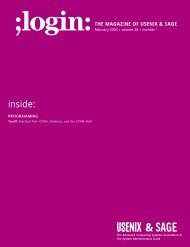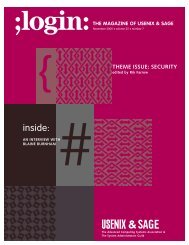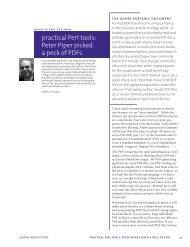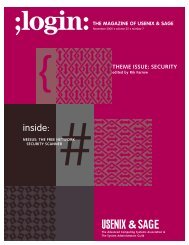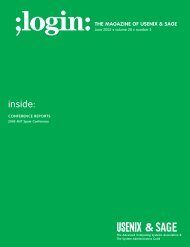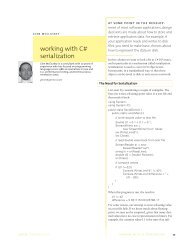inside: Focus Issue: Security
inside: Focus Issue: Security
inside: Focus Issue: Security
You also want an ePaper? Increase the reach of your titles
YUMPU automatically turns print PDFs into web optimized ePapers that Google loves.
A security policy and strategyshould be based on a realisticrisk analysis.4. The San Diego Supercomputer Center,http://www.sdsc.edu.Sid also said that we should have an open environment, where people can do whatthey want to do. (He actually said that if someone wants root access, why not give it tothem?) But he recognized that one person’s actions on one machine can have animpact on other machines on that network.So we developed a long-term strategy to keep our machines and network secure, whileproviding resources that are open and usable. We did not do everything immediately.Rather, we implemented what we could, and improved things as new technologiesbecame available. We also recognized that there are people who just want to do theirown thing, either because they have a need that doesn’t fit with our environment orbecause they have an ego problem, so we also provided a way for those people to managetheir own resources.THE SDSC ENVIRONMENTSDSC is a facility which provides supercomputing resources for scientific research, anddoes research in high-performance computing technology. 4 SDSC is also part of Tera-Grid and Internet2. SDSC does not do any government-classified work.We have about 6000 users, of which only about 300 are on-site. The rest are at otherinstitutions around the globe (mostly in the US).We have several thousand systems on-site and about five petabytes of near-line storage,plus several hundred terabytes of spinning disk on a SAN. Our network supports10Gb Ethernet (no, that’s not a typo) internally and to other TeraGrid sites. We havemultiple OC-192 connections to various sites. In other words, LOTS of bandwidth.We do not insist on absolute homogeneity (more on that below). On-site users gettheir choice of desktop: Linux, Solaris, Windows, or Macintosh. Many users have morethan one desktop machine. Our infrastructure machines are a combination of Linuxand Solaris. Oh, and we have some IRIX machines used by the Visualization group.We currently support the following OS revs:RedHat 7.2, 7.3, 8, 9; Solaris 7, 8, 9; IRIX 6.5; Windows NT4, 2000, 2003, XP (for somespecific applications); MacOS 9, XWe treat hardware as commodity devices. System configuration is independent of thehardware. If a system dies, it is replaced with new hardware and auto-installs. Userdowntime is kept to a minimum, as are support staff resources.RISK ANALYSISA security policy and strategy should be based on a realistic risk analysis. Our analysislooks at the assets we are trying to protect and the threats to those assets.ASSETSTo SDSC, the most important thing to protect is the integrity (and, where necessary,the confidentiality) of our data. In this context, “data” means both user and systemdata (mess with system data and you’ve compromised the machine).We also need to protect our resources: bandwidth, CPU, and data storage capacity.Many of the script kiddies out there don’t want our data (or yours), they just want ourdisk space and bandwidth.36Vol. 28, No. 6 ;login:



